
Lake Ontario is one of the five Great Lakes of North America. It is bounded on the north, west, and southwest by the Canadian province of Ontario, and on the south and east by the U.S. state of New York. The Canada–United States border spans the centre of the lake.

The Farne Islands are a group of islands off the coast of Northumberland, England. The group has between 15 and 20 islands depending on the level of the tide. They form an archipelago, divided into the Inner Group and the Outer Group. The main islands in the Inner Group are Inner Farne, Knoxes Reef, the East and West Wideopens, and the Megstone; the main islands in the Outer Group are Staple Island, Brownsman, North and South Wamses, Big Harcar, and Longstone. The two groups are separated by Staple Sound. The highest point, on Inner Farne, is 62 feet (19 m) above mean sea level.
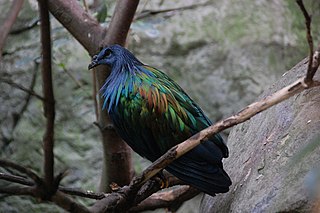
The Nicobar pigeon or Nicobar dove is a bird found on small islands and in coastal regions from the Andaman and Nicobar Islands, India, east through the Indonesian Archipelago, to the Solomons and Palau. It is the only living member of the genus Caloenas alongside the extinct spotted green pigeon, and is the closest living relative of the extinct dodo and Rodrigues solitaire.
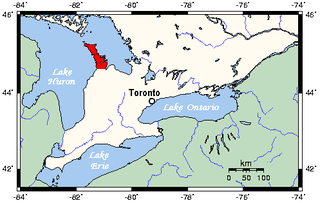
The Bruce Peninsula is a peninsula in Ontario, Canada, that divides Georgian Bay of Lake Huron from the lake's main basin. The peninsula extends roughly northwestwards from the rest of Southwestern Ontario, pointing towards Manitoulin Island, with which it forms the widest strait joining Georgian Bay to the rest of Lake Huron. The Bruce Peninsula contains part of the geological formation known as the Niagara Escarpment.
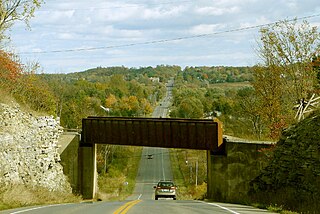
South Frontenac is a township in Frontenac County in eastern Ontario, Canada. It was amalgamated in 1998 from the former townships of Bedford, Loughborough, Portland, and Storrington.

HMS St Lawrence was a 102-gun first-rate wooden warship of the Royal Navy that served on Lake Ontario during the War of 1812. Built on the lake at the Royal Navy dockyard in Kingston, Ontario, she was the only Royal Navy ship of the line ever to be launched and operated entirely in fresh water. Constructed in 1814, the ship's arrival on the lake ended all naval action and St Lawrence finished the war having never gone into battle. Following the war, the vessel was laid up, eventually being sold in 1832 to private interests. The ship was later sunk and is now a recreational dive spot.
The schooner or gunboat HMS Speedy sank in a snowstorm in Lake Ontario south of the future site of Brighton, Ontario, and west of Prince Edward County, on 8 October 1804, with the loss of all hands. The sinking changed the course of Canadian history because of the prominence of the citizens of the tiny colony of Upper Canada lost in the disastrous event.

Lake Memphremagog is a fresh water glacial lake located between Newport, Vermont, United States and Magog, Quebec, Canada. The lake spans both Quebec and Vermont, but is mostly in Quebec. Most of the watershed that feeds the lake is located in Vermont, and is a source for accumulated phosphorus, sediments, and other pollutants. Cleanup efforts since the late 1980s have improved the water quality. The lake furnishes potable water for 200,000 people.

The Imperial Towers of Ontario were six of the earliest lighthouses built on Lake Huron and Georgian Bay, all constructed primarily of stone, by the Province of Canada. The origin of the designation Imperial is not certain, but some historians speculate that because the towers were public construction built under the colonial administration while Canada was a self-governing colony of Britain, the name would assure at least some funding from the British Empire's Board of Trade.
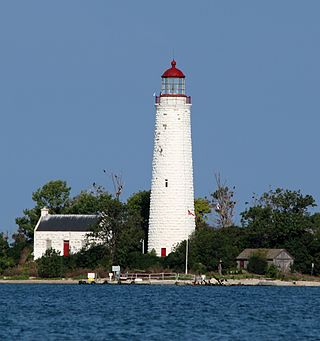
John Brown (1809–1876) was a Canadian builder of Scottish origin.
The George A. Marsh was a three-masted schooner built in Michigan City Indiana in 1882 as a lumber carrier. In 1914, the Marsh was sold to a Belleville, Ontario man as a coal carrier.

Mohawk Island is a small island in the northeast of Lake Erie, in Haldimand County, Ontario, Canada. It is composed of limestone with almost no vegetation, and is close to the water level. It was formerly known as Gull Island and contains the ruins of the Gull Island Lighthouse which was built in 1848 to guide ships into the Welland Canal at Port Maitland. In 1933, the lighthouse was automated to no longer require a human keeper and lost significance in 1934 due to the realignment of the canal at Port Colborne. It was decommissioned in 1969 when the mechanism was destroyed by a fire. The lighthouse is located close to the shore of Rock Point Provincial Park.
Lemoine Point Conservation Area is a 136-hectare (340-acre) recreational conservation area at the west end of Kingston, Ontario. The area is bordered by Collins Bay on the north and west sides, Lake Ontario on the south and Kingston/Norman Rogers Airport on the east.
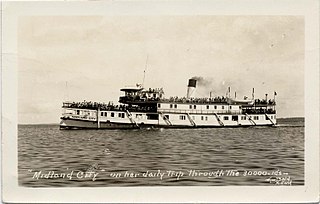
SS Midland City was originally a Canadian side-wheel steamboat that provided passenger and cargo transportation on the Great Lakes from 1871 until 1955. Originally named Maud, then America, she underwent several extensive refits over her 84-year service, and saw several owners. The ship was intentionally run aground and burnt to the waterline in 1955 near the mouth of the Wye River in Midland Bay. The wreck is intact and visible above the water to this day, where it acts as a breakwater for the Wye Heritage Marina and local attraction.

Main Duck Island is a Canadian island in the eastern part of Lake Ontario situated next to the smaller Yorkshire Island. It was purchased by Parks Canada in 1977 and has been administered as part of the Thousand Islands National Park since 1998, even though it is not part of the Thousand Islands region.

Swetman Island, formerly False Duck Island, is a small Canadian island in Lake Ontario, south of Picton, Ontario. It is the largest island in a chain of islands and shoals known as the False Duck Islands, not to be confused with the nearby Main Duck Islands. Nearby Timber Island is also considered part of the False Duck Islands. The False Duck Islands, the Main Duck Islands, and Galloo Island and Stony Island on the US side, and their associated shoals, form the Duck Galloo Ridge.

Scotch Bonnet Island is a small island in Lake Ontario. It is part of Prince Edward County, Ontario, Canada.
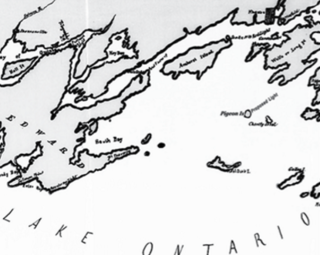
The General Brock was a sailing brig that ran aground on November 26, 1846, on Pigeon Island, Lake Ontario, in Canada. Her crew were rescued by officials from the nearby naval base at Kingston, Ontario.

Wellers Bay is a small bay on Lake Ontario, on the west side of Prince Edward County. In 1861 the Government of the Province of Canada considered making it a "harbour of refuge", and installing a lighthouse.

Timber Island is a 44-hectare (110-acre) island in the east end of Lake Ontario, off Prince Edward County, Canada. It is part of a chain of islands and shoals, including Stoney Island, Galloo Island, Main Duck Island, Yorkshire Island and Swetman Island. Timber Island and Swetman Island, and their nearby shoals, are known as the False Duck Islands.

















